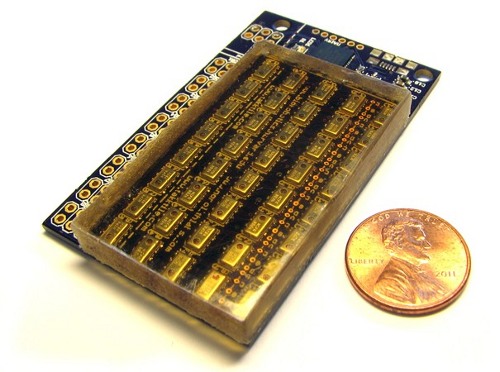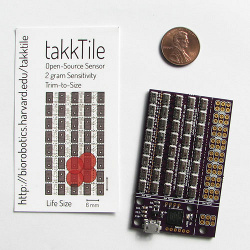 |
| June 04, 2013 | Volume 09 Issue 21 |
Designfax weekly eMagazine
Archives
Partners
Manufacturing Center
Product Spotlight
Modern Applications News
Metalworking Ideas For
Today's Job Shops
Tooling and Production
Strategies for large
metalworking plants
Robot hands get a gentler, much cheaper touch
What use is a hand without nerves, that can't tell what it's holding? A hand that lifts a can of soda to your lips, but inadvertently tips or crushes it in the process?
Researchers at the Harvard School of Engineering and Applied Sciences (SEAS) have developed a very inexpensive tactile sensor for robotic hands that is sensitive enough to turn a brute machine into a dextrous manipulator.

The TakkTile sensor provides gram-level sensitivity in hardware created from MEMS barometers (in this case, an 8 x 5 array of barometers) and standard manufacturing processes. Here you can see a full board encased in rubber, the key to the inexpensive tactile sensing technology.[Photo courtesy: Leif Jentoft.]
The sensor, called TakkTile, is intended to put what would normally be a high-end technology within the grasp of commercial inventors, teachers, and robotics enthusiasts.
"Despite decades of research, tactile sensing hasn't moved into general use because it's been expensive and fragile," explains co-creator Leif Jentoft, a graduate student at SEAS. "It normally costs about $16,000, give or take, to put tactile sensing on a research robot hand. That's really limited where people can use it. The traditional technology also uses very specialized construction techniques, which can slow down your work. Now, TakkTile changes that because it's based on much simpler and cheaper fabrication methods."
TakkTile takes an existing device -- a tiny barometer, which senses air pressure -- and adds a layer of vacuum-sealed rubber to it, protecting it from as much as 25 lb of direct pressure. Jentoft and co-creator Yaroslav Tenzer, a postdoctoral fellow, say that the chips can even survive a strike from a hammer or a baseball bat. At the same time, Takktile is sensitive enough to detect a very slight touch: down to 1 gr of sensitivity.

The 2-gr TakkTile sensor shown here can be customized and trimmed to size. [Photo courtesy of Yaroslav Tenzer]
The result, when added to a mechanical hand, is a robot that knows what it's touching. It can pick up a balloon without popping it. It can pick up a key and use it to unlock a door. (Learn more about how the sensor works and how it is made by clicking here.)
Beyond robotics, Jentoft and Tenzer suggest that the TakkTile sensor could be used in a range of electronic devices. A toy manufacturer could make a stuffed puppy that responds to petting; a medical device designer could create a laparoscopic gripper that's gentle enough to tease apart tissue during surgery.
"Not everyone has the bandwidth to do the research themselves, but there are plenty of people who could find new applications and ways of using this," says Tenzer.
The sensors can be built using relatively simple equipment; the patented process relies on standard methods used in printed circuit board fabrication, along with access to a vacuum chamber. The tiny barometers are available cheaply because they have been widely used in cell phones and GPS units that can sense altitude. The unit uses the MPL115A2 miniature digital barometer chip from Freescale Semiconductor. According to the TakkTile website, "the chips consist of a MEMS diaphragm with a Wheatstone bridge, a instrumentation amplifier, a temperature sensor, multiplexer, analog-to-digital converter, and I2C bus -- all for ~$1 USD." Obviously, this is a key contributor to keeping the total cost of the unit, which in the 8 x 5 array board shown in this article uses 40 MPL115A2 chips, down.
Along with their adviser, Robert D. Howe, Abbott and James Lawrence Professor of Engineering at SEAS, Jentoft and Tenzer are pursuing commercial opportunities with help from Harvard's Office of Technology Development. Harvard plans to license the technology to companies interested in offering prefabricated sensors or in integrating TakkTile sensing into products such as robots, consumer devices, and industrial products. A starter/evaluation kit with a 2-gr sensitivity is available on the TakkTile website for $299.
The TakkTile website encourages open develpment of the technology, so there is information available if you want to try building your own unit instead of buying a starter kit. Plans and a tutorial are available for research and non-commercial use.
Source: Harvard School of Engineering and Applied Sciences
Published June 2013
Rate this article
View our terms of use and privacy policy
